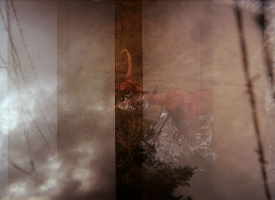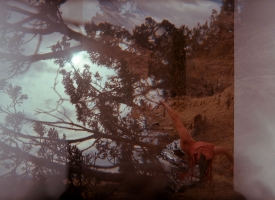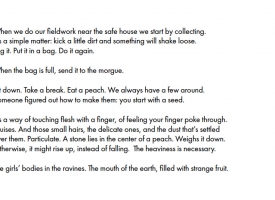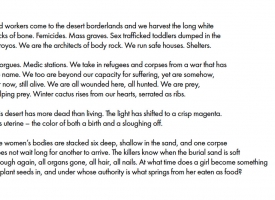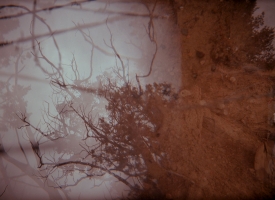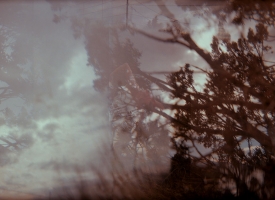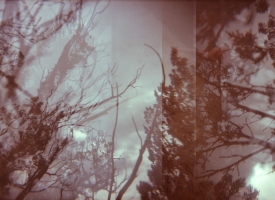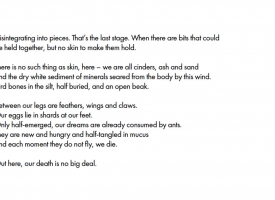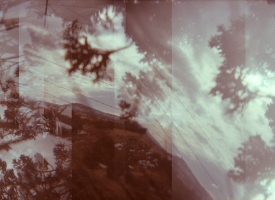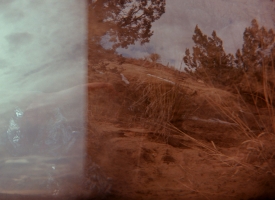FIELDWORK
Project Description
FIELDWORK is currently on exhibition at the Ronald Feldman Gallery in NYC (14 February – March 25, 2015), and published in Guernica magazine (21 March 2015). A suite of photographs, essays, poems, texts, solo performance works, artifacts, video installations, and site-specific gestures, FIELDWORK is based in autobiography and memoir, and inhabits the artist’s decades as an activist in gender-based violence in the Southwest and US-Mexico border. FIELDWORK invokes the artist’s alter-ego, Vulture Vigilante – a skinwalker hybridized of half-woman, half-scavenger of the dead – who returns to the sites where femicided women’s bodies were dumped or buried and hidden. The project surrounds the physical and erotic bodies and psyches of women – field workers, victims, survivors – within the context of pervasive violence and death. It is part of the artist’s body of work OUT HERE DEATH IS NO BIG DEAL addressing the lives of women navigating the tangle of predatory institutional and personal violence in the desert borderlands between Northern Mexico, the Tohono O’Odham Nation, and the southwest United States.
Artist Statement
FIELDWORK is an autobiographical project about my years in the femicide regions of the Southwest and US-Mexico border and Tohono O’Odham Reservation, and my time as a fieldworker setting up safe houses for sex trafficked women and children. For this project, I returned to sites where I used to work, and created a Vulture Vigilante alter ego. Wrapped in one of the mylar FEMA emergency blankets distributed in the safe houses and used by fieldworkers to protect the bodies of dumped women, the Vulture Vigilante both guards the site, exhumes the site, and harvests out the beliefs and behaviors of a human society in which the murders of women and girls are a normalized part of daily life. Her role is shamanic, for she walks between the world of the visible living and the invisible dead…yet she also walks between the versions of reality in which female lives are worthless and our violent deaths unremarkable, and a new future in which our bodies and psyches have intrinsic value. As the Vulture locates these bodies, she reveals that the bodies themselves are also hybrids – the women are being transformed from victims into vigilantes. She stands on their graves, invoking them to rise from the dead and seek retribution, justice, and social change.
I have spent the majority of my life throughout Texas, New Mexico, Arizona, Southern California, the edges of the Navajo Nation and the Tohono O’Odham Nation. Throughout the years, the girls and the women I loved survived, but did not quite live. I knew the sounds of all our voices raised in fear. I knew the shapes our bodies made as we tended our wounds. I knew the color of my neighbor’s hair as the police collected it from her boyfriend’s carpet for evidence after he killed her. Each year something more was missing from each of us. I wanted to grow up and became part of the solution. Over time, I became part of a team. Sometimes we worked for our friends. Other times, we worked for the government. We worked for government contractors and subcontractors. And then we worked for whoever hired us: nongovernmental agencies, quasigovernmental agencies, law enforcement, justice systems, bureaus of investigation, intelligence operations.
Each day, more eviscerated women and children turn up dead. We hold endless meetings of aid workers. The woman who arrived last night, her ear torn off. We dream: whose ears are whose. We listen to ourselves, the stories we tell officials versus the stories we tell each other.
We have reached in with fingers to feel ourselves and we have found our bodies inexplicably disassembled. There is blood, and afterbirth, and sorrow.
Outside the FEMA trailers there are ripples of heat and an odd ice of summer lightning across the lava fields of ancient seabed. The formaldehyde peels our skin. We are snakes in springtime. The woman says to me: what new creatures are we becoming?
Creatures that can defend themselves, I want to say. I think about survival. How unlikely my own has been. How the skin becomes feathers and teeth turn to beak. How in the showers, we are still soft. We bathe the babies’ bruises. So soft, and I see no talons here.
Visual Art
These photos were creating using salvaged damaged film cameras manufactured by fascist dictatorships. The colors, textures, shapes and multiple layers within the photographs are created using only the unique aberrations of the cameras’ optics, and the chemistry of the film, without software or computer manipulation.
Photographs exhibited at the Robert Feldman Gallery / NYC, 14 February – 25 March 2015.
THUMBNAIL GALLERY BELOW. CLICK TO VIEW FULL-SIZE PANORAMIC IMAGES.
Literature
Excerpted from FIELDWORK. Published in GUERNICA, Spring 2015
O ONE O
When we do our fieldwork near the safe house we start by collecting. It’s a simple matter: kick a little dirt and something will shake loose. Tag it. Put it in a bag. Do it again. When the bag is full, send it to the morgue.
Sit down. Take a break. Eat a peach. We always have a few around. Someone figured out how to make them: you start with a seed.
It’s a way of touching flesh with a finger, of feeling your finger poke through. Bruises. And those small hairs, the delicate ones, and the dust that’s settled over them. Particulate. A stone lies in the center of a peach. Weighs it down. Otherwise, it might rise up, instead of falling. The heaviness is necessary.
O TWO O
The girls’ bodies in the ravines. The mouth of the earth, filled with strange fruit.
Published in Guernica Magazine
Film
Performance
Credits
FIELDWORK is part of OUT HERE DEATH IS NO BIG DEAL. FIELDWORK is created with multivalent funding, commissions, and residencies from Creative Capital, the Theo Westenberger Foundation, the Robert Feldman Gallery, Guernica magazine, the Corporation of Yaddo, and the Millay Colony.


